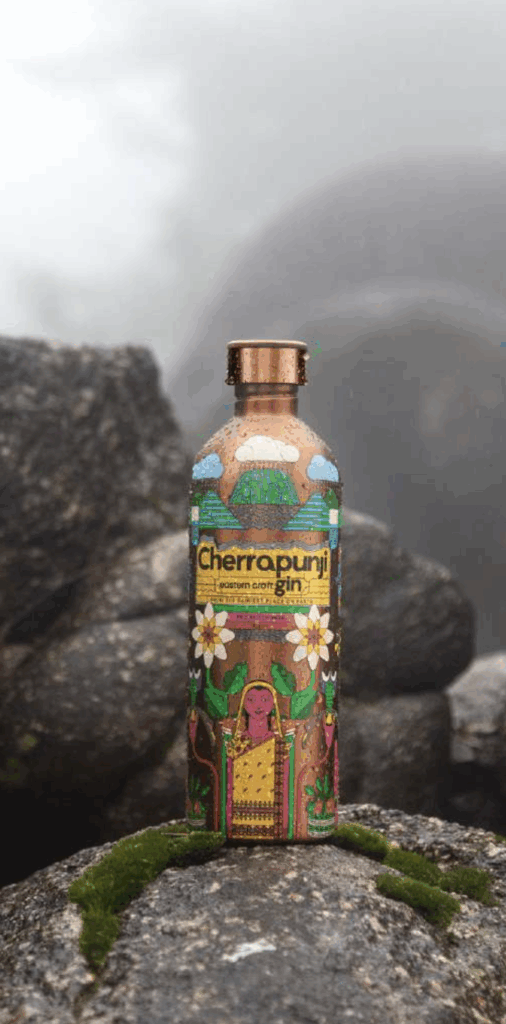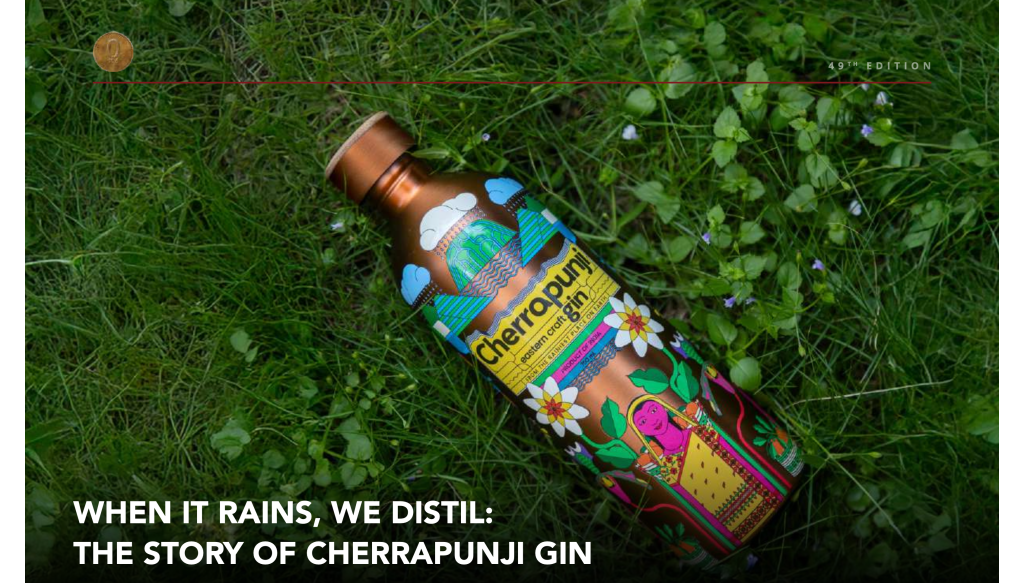
From Features Desk
In the rain-soaked hills of Meghalaya, where
clouds spill over cliffs and forests drip with
monsoon memories, a quiet revolution is
underway. It comes not in the form of policy or
protest, but in a steel bottle filled with liquid craft.
This is Cherrapunji Eastern Craft Gin, India’s first
premium gin distilled from rainwater, and the
country’s first spirit from the Northeast to be
exported to international markets.
Behind this remarkable creation is Mayukh
Hazarika, a Shillong native and the founder of
Raincheck Earth Co. His vision was deceptively
simple: to create a gin that belongs to its place,
both in flavour and in philosophy. “Our approach
to distilling, bottling and sourcing is rooted in
sustainability,” Hazarika says, “we wanted to
show that craft can be innovative without being
wasteful.”
Rainwater in a Bottle
Cherrapunji and nearby Mawsynram are known to be the wettest regions in the world, receiving an astonishing 11,872 mm of rainfall annually.
Cherrapunji and nearby Mawsynram are known to be the wettest regions in the world, receiving an astonishing 11,872 mm of rainfall annually.
For centuries, this abundance has been
romanticised in postcards and geography
textbooks. Hazarika chose to capture it in a glass,
or rather, in steel. The gin is distilled from
harvested rainwater and stored in 100-kilolitre
tanks made of corrosion-resistant steel, ensuring
purity and sustainability.
Unlike most global brands that rely heavily on
groundwater, Cherrapunji Gin embraces the idea
of climate responsiveness. Its rainwater base is
paired with a dozen native botanicals sourced
within a few hundred kilometres of the distillery:
the GI-tagged ‘Khasi mandarin’ and ‘Kaji Nemu’
(Assamese lemon) lend bright citrus notes,
Himalayan juniper berries form the smooth base,
and the addition of wild peppercorns, black and
green cardamoms, and smoked tea from
Mizoram’s Lushai Hills gives it layers of spice,
warmth, and a smoky aftertaste. The result is a
spirit that feels both local and world-class; rooted
in terroir yet universal in appeal.
Steel Over Glass
Perhaps the boldest design choice lies not in the recipe but in the packaging. Cherrapunji Gin comes in a reusable, military-grade steel bottle weighing barely 158 grams, nearly two-thirds lighter than standard glass bottles of the same size.
Perhaps the boldest design choice lies not in the recipe but in the packaging. Cherrapunji Gin comes in a reusable, military-grade steel bottle weighing barely 158 grams, nearly two-thirds lighter than standard glass bottles of the same size.
This reduces freight emissions, eliminates
breakage, and turns packaging into a tool rather
than waste. “There’s no reason packaging has to
be discarded,” Hazarika insists, “If someone
reuses the bottle every day, we’ve succeeded.”
At a time when even premium global spirits are
still wedded to ornate glass, this move signals a
radical rethink. It’s not sustainability as a
marketing claim; it’s sustainability as product
design.
From Shillong to the World
Launched in 2021, Cherrapunji Gin has already carved a space in the global spirits conversation. It is available across the European Union and soon in Japan, Thailand, and the UK. The brand has collected 14 international medals in just two years, including a Double Gold Medal at the 2025 SIP Awards in California, the world’s only major spirits competition judged exclusively by consumers. Out of 1,200 entries from 60 countries, fewer than 2 percent earned the accolade.
Launched in 2021, Cherrapunji Gin has already carved a space in the global spirits conversation. It is available across the European Union and soon in Japan, Thailand, and the UK. The brand has collected 14 international medals in just two years, including a Double Gold Medal at the 2025 SIP Awards in California, the world’s only major spirits competition judged exclusively by consumers. Out of 1,200 entries from 60 countries, fewer than 2 percent earned the accolade.
For Hazarika, this recognition is personal: “To
have our gin, rooted in Meghalaya’s rain and local
identity, resonate with everyday drinkers in
California is a reminder that authenticity and craft
can connect across cultures.”
The brand’s innovative model has also caught
academic attention. The Indian Institute of
Management has developed a case study on
Raincheck Earth Co., citing it as a pioneering
example of blending sustainability with premium
craft.


More Than a Drink
Cherrapunji Gin isn’t merely another entrant into India’s growing craft spirits market, it is a distilled story of its geography, rain bottled, biodiversity preserved, and culture celebrated. Its citrus-forward, smoky-earthy profile makes it versatile: enjoyable neat, with a tonic, or in cocktails where its complexity shines.
Cherrapunji Gin isn’t merely another entrant into India’s growing craft spirits market, it is a distilled story of its geography, rain bottled, biodiversity preserved, and culture celebrated. Its citrus-forward, smoky-earthy profile makes it versatile: enjoyable neat, with a tonic, or in cocktails where its complexity shines.
As the global spirits industry grapples with
sustainability, Cherrapunji Gin suggests a
playbook that feels both Indian and
forward-looking; local sourcing,
climate-conscious design, and storytelling that
doesn’t imitate but innovates. In a world often
thirsty for authenticity, perhaps the wettest place
on Earth has offered just the drink to quench it.

